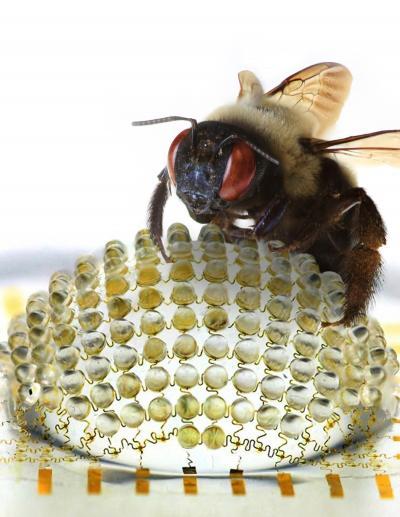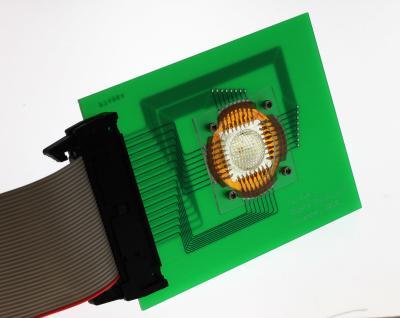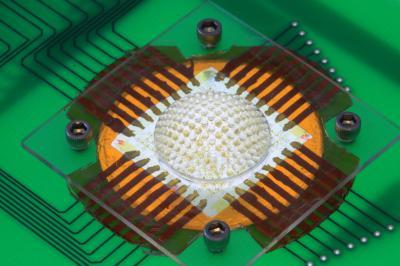An interdisciplinary team of researchers has created the first digital cameras with designs that mimic those of ocular systems found in dragonflies, bees, praying mantises and other insects. This class of technology offers exceptionally wide-angle fields of view, with low aberrations, high acuity to motion, and nearly infinite depth of field.
Taking cues from Mother Nature, the cameras exploit large arrays of tiny focusing lenses and miniaturized detectors in hemispherical layouts, just like eyes found in arthropods. The devices combine soft, rubbery optics with high performance silicon electronics and detectors, using ideas first established in research on skin and brain monitoring systems by John A. Rogers, a Swanlund Chair Professor at the University of Illinois at Urbana-Champaign, and his collaborators.
"Full 180 degree fields of view with zero aberrations can only be accomplished with image sensors that adopt hemispherical layouts – much different than the planar CCD chips found in commercial cameras," Rogers explained. "When implemented with large arrays microlenses, each of which couples to an individual photodiode, this type of hemispherical design provides unmatched field of view and other powerful capabilities in imaging. Nature has developed and refined these concepts over the course of billions of years of evolution." The researchers described their breakthrough camera in an article, "Digital Cameras With Designs Inspired By the Arthropod Eye," published in the May 2, 2013 issue of Nature.

The new digital cameras exploit large arrays of tiny focusing lenses and miniaturized detectors in hemispherical layouts, just like eyes found in arthropods.
(Photo Credit: John A. Rogers, University of Illinois at Urbana-Champaign)
Eyes in arthropods use compound designs, in which arrays of smaller eyes act together to provide image perception. Each small eye, known as an ommatidium, consists of a corneal lens, a crystalline cone, and a light sensitive organ at the base. The entire system is configured to provide exceptional properties in imaging, many of which lie beyond the reach of existing man-made cameras.
The researchers developed new ideas in materials and fabrication strategies allowing construction of artificial ommatidia in large, interconnected arrays in hemispherical layouts. Building such systems represents a daunting task, as all established camera technologies rely on bulk glass lenses and detectors constructed on the planar surfaces of silicon wafers which cannot be bent or flexed, much less formed into a hemispherical shape.
"A critical feature of our fly's eye cameras is that they incorporate integrated microlenses, photodetectors, and electronics on hemispherically curved surfaces," said Jianliang Xiao, an assistant professor of mechanical engineering at University of Colorado Boulder and coauthor of the study.
"To realize this outcome, we used soft, rubbery optics bonded to detectors/electronics in mesh layouts that can be stretched and deformed, reversibly and without damage."
The fabrication starts with electronics, detectors and lens arrays formed on flat surfaces using advanced techniques adapted from the semiconductor industry, said Xiao, who began working on the project as a postdoctoral researcher in Rogers' lab at Illinois. The lens sheet—made from a polymer material similar to a contact lens—and the electronics/detectors are then aligned and bonded together. Pneumatic pressure deforms the resulting system into the desired hemispherical shape, in a process much like blowing up a balloon, but with precision engineering control.

The new digital cameras exploit large arrays of tiny focusing lenses and miniaturized detectors in hemispherical layouts, just like eyes found in arthropods. Full 180 degree fields of view with zero aberrations can only be accomplished with image sensors that adopt hemispherical layouts.
(Photo Credit: John A. Rogers, University of Illinois at Urbana-Champaign)
The individual electronic detectors and microlenses are coupled together to avoid any relative motion during this deformation process. Here, the spaces between these artificial ommatidia can stretch to allow transformation in geometry from planar to hemispherical. The electrical interconnections are thin, and narrow, in filamentary serpentine shapes; they deform as tiny springs during the stretching process.
According to the researchers, each microlens produces a small image of an object with a form dictated by the parameters of the lens and the viewing angle. An individual detector responds only if a portion of the image formed by the associated microlens overlaps the active area. The detectors stimulated in this way produce a sampled image of the object that can then be reconstructed using models of the optics.
Over the last several years, Rogers and his colleagues have developed materials, mechanics principles and manufacturing processes that enable classes of electronics that can bend, twist, and stretch like a rubber band. This device technology has been used in fields ranging from photovoltaics, to health/wellness monitors, to advanced surgical tools and digital cameras with designs of the mammalian eye.
"Certain of the enabling ideas build on concepts that originated in our labs a half dozen years ago," Rogers remarked. "Ever since, we have been intrigued by the possibility of creating digital fly's eye cameras. Such devices are of longstanding interest, not only to us but many others as well, owing to their potential for use in surveillance devices, tools for endoscopy, and other applications where these insect-inspired designs provide unique capabilities."

The new digital cameras exploit large arrays of tiny focusing lenses and miniaturized detectors in hemispherical layouts, just like eyes found in arthropods. Full 180 degree fields of view with zero aberrations can only be accomplished with image sensors that adopt hemispherical layouts.
(Photo Credit: John A. Rogers, University of Illinois at Urbana-Champaign)